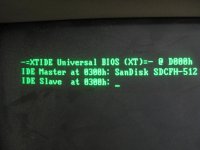Minerva10210
Experienced Member
The 5155 contains a 5160 motherboard. All three revisions of the 5160 BIOS/POST do the checksum check.
It could be by coincidence that the 5160 found the ROM contents to checksum to 00.
It may be prudent here to mention that my 5155 does not have the original IBM board in it unfortunately, but a DTK 8MHz 8088 equipped mobo...



